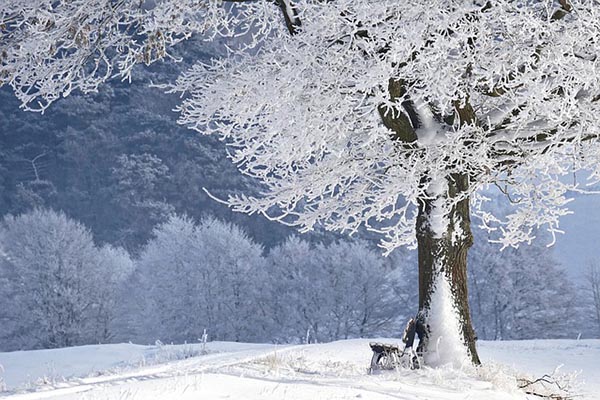Fall Camping (Part I)
 Although summer is a time set aside for camping and outdoor sports I find it is too hot-muggy-buggy, and the campgrounds are packed with people.
Although summer is a time set aside for camping and outdoor sports I find it is too hot-muggy-buggy, and the campgrounds are packed with people.
I prefer the fall time with the leaves turning and of course this lends itself to hunting by many nimrods. I had thought to talk about what I would pack in with me for comfort of sorts on a ten-mile (easy) hike, or canoe trip in the north.
Hiking in requires good sturdy lightweight leather boots. The Army combat boots-Desert boots usually weigh one pound each. This is important as each step you are lifting weight and that weight adds up. The soles need be some type of alligator ribbed type grip with vents on the side are excellent along with a solid ankle support and high arch. Sizing is important as when you are walking great distances your feet expand a bit. Although my foot is a US 10, I order a US10 ½. This compensates for the thick double pair of sox I wear for a cushion. I also prefer a wide size. The rule of thumb is that your city fashionable pointed toe shoes are going to bind up and cause blisters. You require comfortable boots that will carry you miles and miles.
While we are on the subject of outdoor hiking shoes consider carrying a small can of foot powder and some spot Band-Aids for the occasional blister. For the sox I recommend “Carheart” brand, a thick outer sox and a lighter 2nd pair of sox.
Some good people are looking at “logger boots”. These tight fitting high heel boots are made for logging and unsuitable for long hikes-they do not give.
Snake country such as Florida might encourage looking at high cut snake proof boots. This is excellent except they will on a long walk, even a short walk, cause blisters. Snake proof boots are a specialty, and not for hiking.
Winter ice and snow implies severe cold and wet. The best boots I have found, and what I use around the homestead in the winter muck is rubber bottoms, leather tops and felt lined at –70 F below temperatures. Of course these are all wide boots and sized at US 10 ½. Your foot may be larger or smaller.
On the long hike good ankle support is necessary, also toe protection; to keep the boots light use fiberglass toecaps. I prefer lace holes to reeve the nylon lines up to the top for a snug fit. The shoelaces you buy are really weak. You might try making some lacing out of parachute shroud cord. Burn the tips with a match taking care not to burn your fingers as nylon melts and drips. Make two extra pair. The real Army boots have a steel plate in the bottom sole to prevent nails and such from puncturing your foot. Civilian shoes rarely have this feature. Sooner or later you will step on a nail. You must have a tetanus shot at least every 5 years. I get one about every 3 years. If you step on a nail, miles from anywhere you must treat the puncture immediately by removing the boot and nail. Use a tube of anti-bacterial and squirt it in the puncture. You can expect a sore foot but if the redness, which is inflammation, spreads outward you best hobble back to an emergency room for a $1700.00 treatment. Look for the steel protection plate in the soles. The problem with nail punctures is that they may drive a piece of rubber up into the foot, which spreads infection.
You could have a shoe repair shop make a pocket folding knife holster for the outside of the boot, but to carry a straight blade knife, even in a sheath in your boot is asking for trouble. Many would-be Rambos die alone in the forest from severing a leg artery.
Long outdoor grade trousers with suspender buttons, or grips with 2” belt loops are best cut extra long to tuck into the boot tops. If ticks still are about you will want to spray your trousers and boots with a tick repellent. I prefer to tuck the trouser cuffs into the boots and leave the sox inside the trousers, as this is what the ticks grab onto first- warm fuzzy socks.
Long sleeve button cuff shirts are a must especially with mosquitoes.
I think suspenders are best for heavy-fat-older men, as their stomach gets larger and the hips smaller allowing the trousers to slide down. Many men try to compensate by tightening the belt but this interferes with blood supply and general health. Younger men usually do well with a wide work belt, and on that belt if they carry a sheath knife it is carried behind the hip, and the sheath stuck in the hip pocket so you do not lose it, or it slides around to the front so you stab delicate parts.
I must mention knives at this point. You do not need a 5-pound Bowie knife. A small bladed knife is the most useful, often billed as a trout and bird knife. The folder knife is good too!
Trekking through a jungle a machete is useful. Although many machete blades proliferate the catalogs, still the best, from my experience is the 1944 True Temper US Army machete. Good balance and ridged metal. This weighs about 1 pound with the canvas sheath, which is affixed to your pack. The great Nessmuk from the late 1800’s as mentioned by the Forester Horace Kepheart, sought vainly for a 1-pound hatchet. There is a one pound hatchet, double blade in the outdoor catalogs; also billed for tomahawk throwing. This would be advantageous for cutting lightwood although for many years I was content with the machete.
Open country dictates a wide brim African Safari type hat with a cool band ™ and a mesh top. Cold weather a double knit wool watch cap does wonders for keeping warm.
Leather gloves and a neck scarf complete your ensemble except for a jacket/coat.
The shooting vest is great for warm weather outer wear, but with mine the multiple pockets filled up with gadgets I must have; it weighed a ton. So we have to cut back on all the really unnecessary items. Perhaps your compass, matches in a container, map is sufficient.
In my young days feather down was the best for warmth. Today I use thinsulate as it is light and if it gets torn in the brush I am not leaving a trail of feathers. The advantage of down jackets and sleeping bags aside from warmth is that they float. This is a factor when canoeing in the far north.
All the water on this planet is polluted and unfit to drink from a running stream-if not from the dead animals upstream, but from other hikers pooping in it, and or course acid rain etc. Pack in a couple quarts of water in aluminum canteens. Treat the water by habit with Hazelton, or iodine, or perhaps what is the latest water purification. Then when you find the sparkling spring you will always treat the water. I prefer aluminum canteens as you can heat the water in the canteen and slip the canteen inside the sleeping bag on a cold night for extra warmth. The current use of plastic canteens limits use and they usually split when you fall down on them, or get rough with your pack where they are affixed. You will not get enough aluminum toxicity from the canteens on this short trip.
By soaking the canteen cover you can keep the water cooler on hot days.
Our next issue will discuss sticks and stones and lean into advanced hiking.
God Bless,
Old Timer
Copyright: 2013, Back2theLand.com, all rights reserved.



